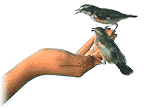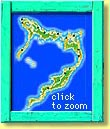T H E I S L A N D S
..................................
Acklins and Crooked Island are two of the four islands forming an atoll which hugs the beautiful shallow waters of the Bight of Acklins. Bordered by the nearly uninhabited Castle Island and Long Cay, they are as natural as they were when The Bahamas was first "discovered." Columbus reputedly sailed down the leeward side of the islands through the narrow Crooked Island Passage, which has ever since served as an important route for steam ships travelling from Europe to Central and South America. This seaway, referred to locally as 'the going through,' also earned these islands the notorious reputation as convenient bases for buccaneers and pirates, who attacked ships in these shallow waters.
The islands existed in virtual obscurity until 1783, when American Loyalists began to settle here. These former plantation owners brought slaves and money to start a short-lived cotton industry which, by the beginning of the 19th Century, had more than 40 plantations employing 1200 slaves. The population turned from the land to the bounties of The Bight, after cotton growing became uneconomical due to Emancipation and soil depletion. Diving for sponges became the economic cornerstone of these islands until the sponges were decimated by a fungus. The inhabitants now earn their living by fishing and simple farming.
AcklinsOne of the least known islands of The Bahamas, Acklins comprises the southern and southeastern part of the chain. The terrain is hilly and desolate, with unusual rock formations, and varied plant and animal life, including an occasional swamp turtle. Along its coastline are numerous hidden coves with extensive, beautiful beaches and a number of tiny, colorful, villages.
The
island is so quiet that you can hear the tropical breezes blow
and the natives say that you have to "make your own sunshine:" in
other words, you are on your own. Bonefishing, deep-sea fishing, sailing, scuba
diving, snorkeling, swimming and
sunbathing are ideal activities.
Crooked Island (together with Long Cay) forms the northwest part of the atoll system. The deliciously sweet scent of native herbs and flowers inspired Columbus to call it "one of the fragrant islands." He christened the island "Isabella" after his queen and it was called "Samoete" by the Arawaks, but somehow, the more functionally descriptive Crooked Island is the name it is known by today.
 Quiet
and remote, the island's natural attributes are many. An abundance
of bird life thrives on the cliffs and reefs around the islands
and magnificent limestone caves hide secrets from the past.
Coral gardens, shelves and reefs are a treat for divers and the
deep creeks, tidal flats, and pools filled with game fish make
it a sportman's delight. Spectacular, untouched, white sand beaches stretch
for miles.
Quiet
and remote, the island's natural attributes are many. An abundance
of bird life thrives on the cliffs and reefs around the islands
and magnificent limestone caves hide secrets from the past.
Coral gardens, shelves and reefs are a treat for divers and the
deep creeks, tidal flats, and pools filled with game fish make
it a sportman's delight. Spectacular, untouched, white sand beaches stretch
for miles.
Colonel Hill, on the northeastern end, is the main town of Crooked Island; other towns include Cripple Hill, True Blue, French Wells and Gun Point. Albert Town, now classified as a ghost town, is the only village on Long Cay. Formerly known as Fortune Island, in more prosperous times it served as a transfer point for cargoes on ships sailing between Europe and the Americas.
Copyright (c) 1995-2013 InterKnowledge Corp. All rights reserved. |
